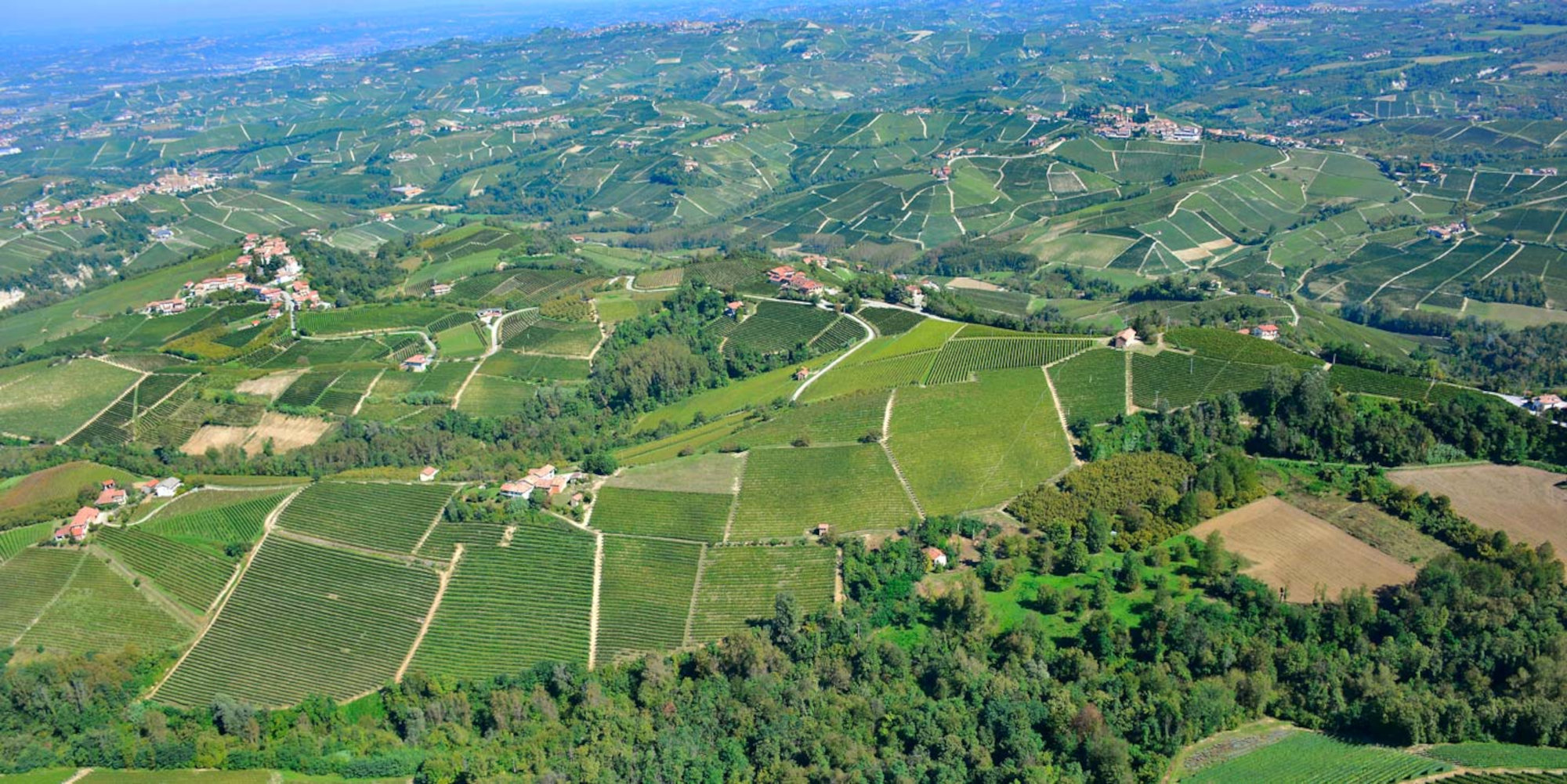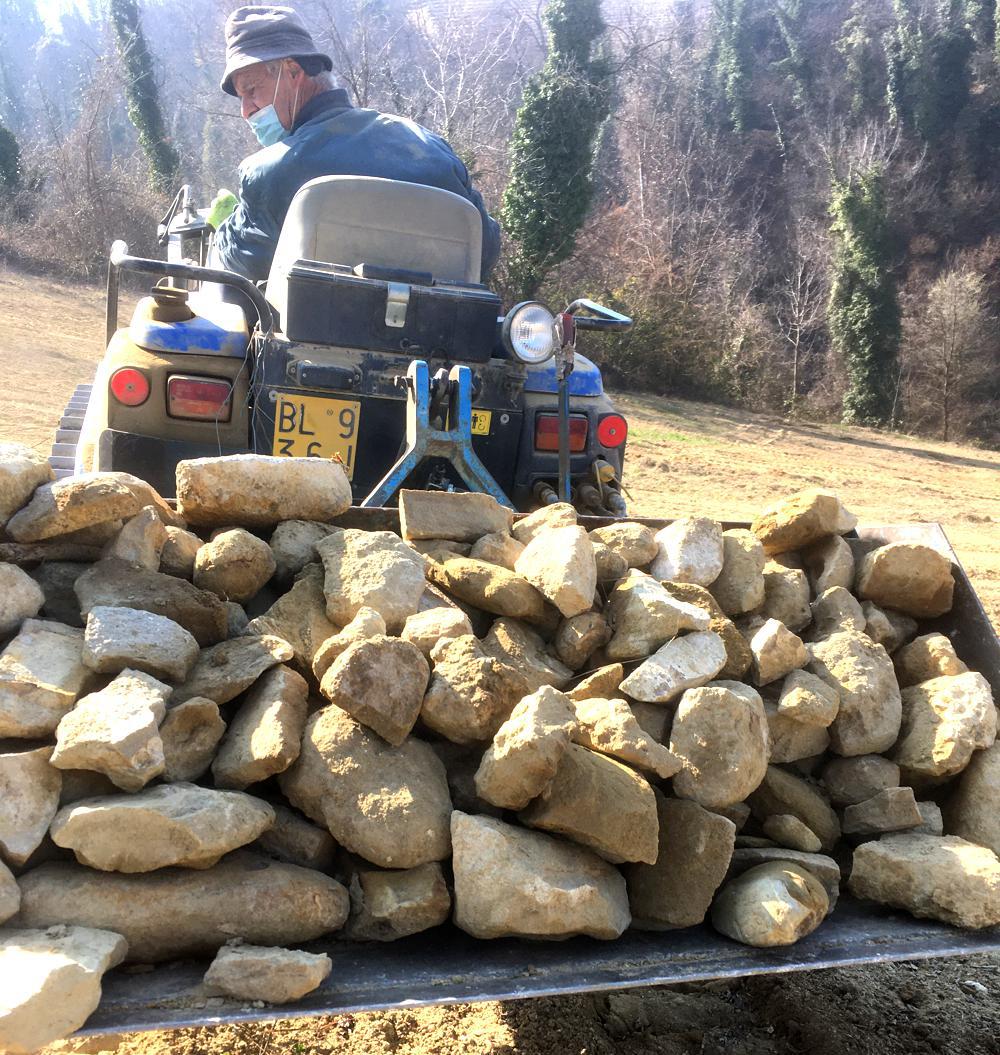We cultivate the heart of Barolo
Castelletto, located under the town of Monforte d’Alba, is in the heart of the Barolo hills, recognized as a UNESCO World Heritage Site.
A strip of land that rises on the ridge of Perno, at around 450 meters, atop which rises the Manzone winery. We are in a magnificent crossroads: Castiglione Falletto to the north, Monforte d’Alba to the south, Barolo to the west, Serralunga d’Alba to the east, in a valley of steep slopes, surrounded by ancient woods and held by the majestic Alpine arc on the horizon.
Poor and stony earth, where agriculture has always had to struggle with arid and poor soil. On these slopes, mild in winter and breezy in summer, the vine has found its perfect home: this allows for low yields and high-quality production, with limited use of products for plant protection.
HARMONY GIVEN BY THE TIME
The vineyards of the Manzone family have learned to live and thrive in situations of constant scarcity, stubbornly yet skillfully adapting to Castelletto’s harsh conditions. They drew strength from scarcity and found wealth amidst poverty.
After almost a century of viticulture, a natural and harmonious ecosystem has been created in the Manzone vineyards. A real miracle of adaptation, today expressed in wines representing the territory, whose characteristics embody the intrinsic nature of Castelletto and its extraordinary, albeit austere, terroir.

VINEYARDS
The Manzone family has 13.5 hectares, of which a little about 8.5 hectares are planted with vineyards, all found within the Barolo appellation and for most part spreading around the Castelletto farmhouse.
There are two Menzioni Geografiche Aggiuntive (MGA) claimed for Barolo, Castelletto and Gramolere, both suitable for excellent viticulture due to the very nature of the soils, which are particularly meager and poor in organic matter.
THE EXPRESSIVE POWER OF TIME
The Castelletto Menzione Geografica Aggiuntiva is the historical heart of the Manzone family and is the vineyard that grandfather Giovanni inherited from his father Stefano. About one hectare facing east-southeast, surrounding Ciabot del Preve, the original core of the winery’s present headquarters. Steep and precipitous, characterized by very poor, stony soils, a mix of clayey marl, sandstone, strips of surface sand and limestone, it yields the winery’s most iconic Barolos: austere and structured wines, of great power and strong color, with well present but smooth tannins, and an almost sweet aftertaste. Muscular and virile Barolo wines endowed with great longevity, they can always give new emotions and develop over time
The Castelletto vineyard, outside the boundaries of the MGA, also extends to the west. Here it is cultivated with Rossese Bianco and Dolcetto and yields juicy and fruity wines with an important structure.
GROWING WINE ON STONES
Gramun e pere, or «weeds and stones». This was the historic name of the area between Perno and Monforte d’Alba, nestled in the midst of the Bussia and Castelletto MGAs.
Nothing grew in Gramolere, except for vines, driven by arid and poor soils to seek nourishment underground. Since the early 1970s, Manzone has cultivated about 3 and a half hectares within the MGA, divided into two plots.
Gramolere Soprana, the highest part of the vineyard, enjoying excellent exposure, is cultivated with Nebbiolo for Barolo, presenting sandy, stony and calcareous soil; and Gramolere Sottana, characterized by a cooler microclimate and more clayey soil, planted with Barbera and Rossese.

CRUTIN DELLE GRAMOLERE
In Piedmontese dialect, crutin refers to a small cavity dug into the rock using pick axes. These served as an underground warehouse for storing tools and, in some cases, for refining wines.
Crutin delle Gramolere, a small hamlet near Monforte d’Alba, has gotten its name in a similar fashion: after the war, its owner – a certain Gepinat – had dug a small cave near his farmhouse. This deep cavity was dug on the side of the hill and allowed access to a spring, which was an important source of water at a time when the area did not have public waterworks.
Gepinat was a grumpy countryfolk, just like all old men in Langa. But he was kindhearted and had always got along well with the Manzone family, who owned some plots in Gramolere, next to his property. Gepinat was a solitary man: he loved to hunt truffles and even founded a training school for truffle hunting dogs in Crutin. He would mostly stay at home and only went to town once or twice a week: he would cross the vineyards and the woods on foot because he didn’t have a car nor a bicycle.
After Gepinat passed away, the house in Crutin was sold to a family from Turin, who had placed a motorized rope in the grotto to extract water from the spring. In the 2000s, the Crutin was purchased by Giovanni Manzone together with the vineyards: the vine rows were recovered and reorganized. Today, the area is planted with Nebbiolo grapes destined to produce Barolo and Langhe Nebbiolo.
CASA DELLA MARCHESA
Located in the hamlet of Gramolere, Casa della Marchesa was owned by Marquise Scarampi del Cairo. She belonged to a noble Piedmontese family who owned a large palace in Monforte d’Alba. The Casa was intended for sharecroppers, who were farmers that shared the proceeds of the harvest with the land owner. This unique building has thick walls and buttresses, suggesting that it could have served as a stronghold during the Napoleonic era.
Casa della Marchesa has played a role in the story of the Polesine. Following the catastrophic flood in 1951, it housed a family of refugees who had three children. It was around at that time that Giovanni Manzone started to hang around its premises to play with his peers. «I learnt the Venetian dialect even before I learnt Italian», says Giovanni, «It was what I heard at my friends’ house. I remember that our teacher used to pick us up at Casa della Marchesa. She would park her scooter by the portico, and we would go together to the nearby school of Castelletto, a small hamlet in Monforte d’Alba».
After being abandoned for years, Casa della Marchesa was bought by the Manzone family in 2002, together with a hectare of land now planted with Nebbiolo destined for Barolo. Renovation operations have also started: the family is planning to open a facility dedicated to hospitality in the near future.
WINES OF SOPRANA
Barolos from Gramolere Soprana are less fierce and austere than those of Castelletto, but are more floral, ethereal, with a slightly lighter color. A subtlety that enhances the scents, making them blunt, straightforward and more open – in short, classic. These rows yield Gramolere Barolo Riserva, aged for at least 7 years before being released on the market: 5 years in large barrels and 2 in the bottle.
WINES OF SOTTANA
Sottana produces important Barberas with exceptional character and structure, showing outstanding complexity and enviable ability to withstand time.
POWER AND ELEGANCE
Purchased in 1989, the Bricat vineyard was named after its old owner who used to have lunch in the ciabot («tool shed») that can still be found in the middle of the rows when he came to work there. Ciabot Bricat stretches for just under one hectare at the foot of Gramolere Soprana and borders one of the largest wooded areas in Barolo. The soils, characterized by red clays and limestone, yield wines of excellent complexity and structure, rich and presenting perfect balance between power and elegance.
THE HISTORY OF BRICAT
Purchased in 1989, the Bricat vineyard was named after its old owner who used to have lunch in the ciabot («tool shed») that can still be found in the middle of the rows when he came to work there. Ciabot Bricat stretches for just under one hectare at the foot of Gramolere Soprana and borders one of the largest wooded areas in Barolo. The soils, characterized by red clays and limestone, yield wines of excellent complexity and structure, rich and presenting perfect balance between power and elegance.
Ciabot Bricat. This is how Luigi Cortellesi’s small hut (ciabot in Piedmontese dialect) in Monforte d’Alba is famously called. He was known as Gigi Bricat, a nickname that perfectly described him: in the local dialect, bricat is a matchstick, and Gigi was a passionate and fiery guy who gets all worked up over nothing. But bricat also refers to a bricchetto, a “small hill” that indicates where his ciabot was located among the rows on Gramolere.
Gigi Bricat was deeply dedicated to his vines: sometimes, he would eat and sleep in his hut, which had a room upstairs and was equipped with a well. He was also famous thanks to his father, who was one of the first farmers to have bought a mechanical thresher. His father would go from one farmhouse to another, lending his machine to the whole area. After all, threshing was a ritual: men would drive to where the thresher was and make use of it. They would be rewarded with a lavish communal lunch in one of the neighboring farmhouses as part of their payment. It required a lot of effort but also enabled people to work and come together: they would sing and drink, even inviting inhabitants of nearby villages to join them for the feast.
After Gigi Bricat passed away in the early 90s, his children continued to bring their grapes to Terre del Barolo, a winemaking cooperative. The Manzone family, who owned the surrounding vineyards in Gramolere, later acquired Bricat.
Today the Bricat is vinified as a single vineyard, and it yields a persistent Barolo with intense aromas. A long-lived wine that needs time to open up and reveal its deep, complex and mysterious soul.
THE NEWSLETTER
Sign up to stay updated on our activities and events


